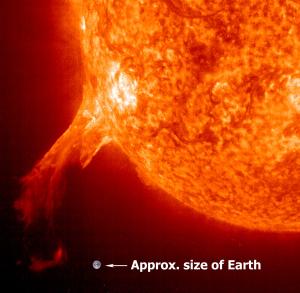Solar flares, a stellar equivalent to ELMs
What is above is like what is below; some of the phenomena that happen at the surface of the Sun are very much like those that occur, here on Earth, in fusion plasmas.
ELMs are of course a zillion times less energetic than the smallest of solar flares and their effect remains confined to the vacuum vessels of fusion devices. However, in a similar manner to solar flares, ELMs deposit their considerable heat load on the components that protect the reactor vessel walls from the plasma, accelerating their erosion and releasing impurities into the plasma.
"The physics of both phenomena are very much the same," explains Wayne Houlberg, a physicist at the ITER Directorate for Plasma Operation. "It's the size and energy that differ." The energy released by the largest ELMs in today's fusion devices is on the order of one Megajoule, whereas a large solar flare is more energetic by a factor of 1 followed by 19 zeros.




